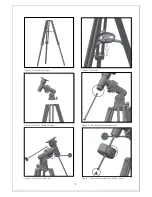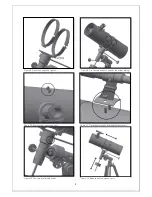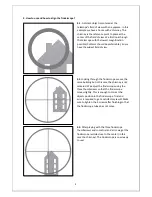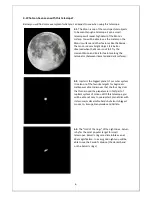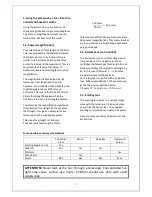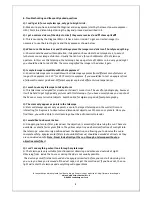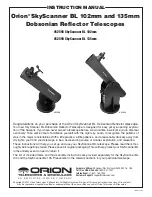
2
The
Zoomion® Gravity 150 EQ
Congratulations on the purchase of the new Zoomion
®
Gravity 150EQ. This telescope will give you
hours of fun, with its all optical glass mirror and light gathering capability, it is the ideal companion
to start in the world of amateur astronomy. With this telescope you will be able to see the craters on
the Moon, star clusters, some nebulae the Jupiter disc features and its Galilean moons and the rings
of Saturn. We have included many accessories so it will be easy to use this telescope.
1. Included parts
we have included several accessories that will make the use of the telescope easier and fun, please
take a look at the list of the parts so you can identify them in the future.
1.
1.5x Erecting Lens;
2, 3.
Two eyepieces 1.25” (31.75mm); a PL25mm and a PL6.5mm eyepiece;
4.
6x Finderscope;
5.
Moon filter;
2. Getting Started.
It is very simple to get started. Here is how the
telescope works. The telescope aperture should
point to the object being observed. The mirror
on back of the tube will gather the light coming
from the object and reflects it to the secondary
mirror that brings it to the eyepiece. Close to
the aperture there is the focuser. The focuser
moves up and down to get a precise focused
image. At the focuser one can use the supplied
accessories. Different accessories combinations
give different results, such as different image
magnifications or correct image for example.
But all this will be explained in detail in the next
pages.
3. Assembly.
Start by assembling tripod (figure
2), place the accessory tray (figure 3), the tray will be useful when observing as a platform for
accessories. Next the equatorial mount should fit the top of the tripod (figure 4). Tighten it carefully,
all telescope weight will be laying on it. Thread the counter-weight shaft (figure 5) and the fine
adjustment knobs (figure 6), make also sure these are well tightened. The counterweight slides on
the shaft and should also be place at half the shaft length (figure 7). Make sure the foot-saver is also
in the right place at the end of the shaft it prevents the counterweight from accidentally drop. The
two supplied optical tube rings should be placed as shown (figure 8). Insert the optical tube and
make sure to tighten the ring knobs (figure 9). They prevent the tube from sliding off. Now it is time
to place the finderscope (remove the finderscope thumbnuts and place the finderscope pointing to
the telescope’s aperture – figure 10 and 11). By unlocking the two knobs (figure 12) you can point
the telescope to any direction. Before starting using the telescope one last thing is required, you
need to balance the telescope. Loosen the tube rings so the tube slides and adjust it so when it is
balanced. Do the same for the counterweight (figure 13).
Figure 1. Parts list.



